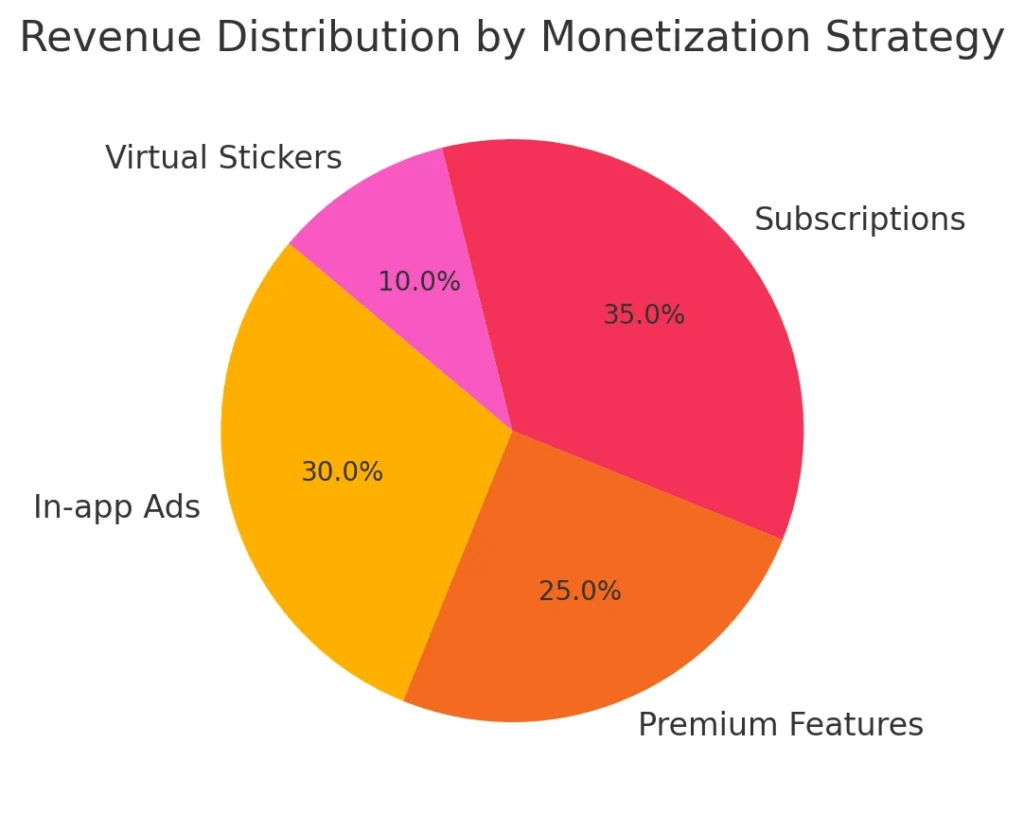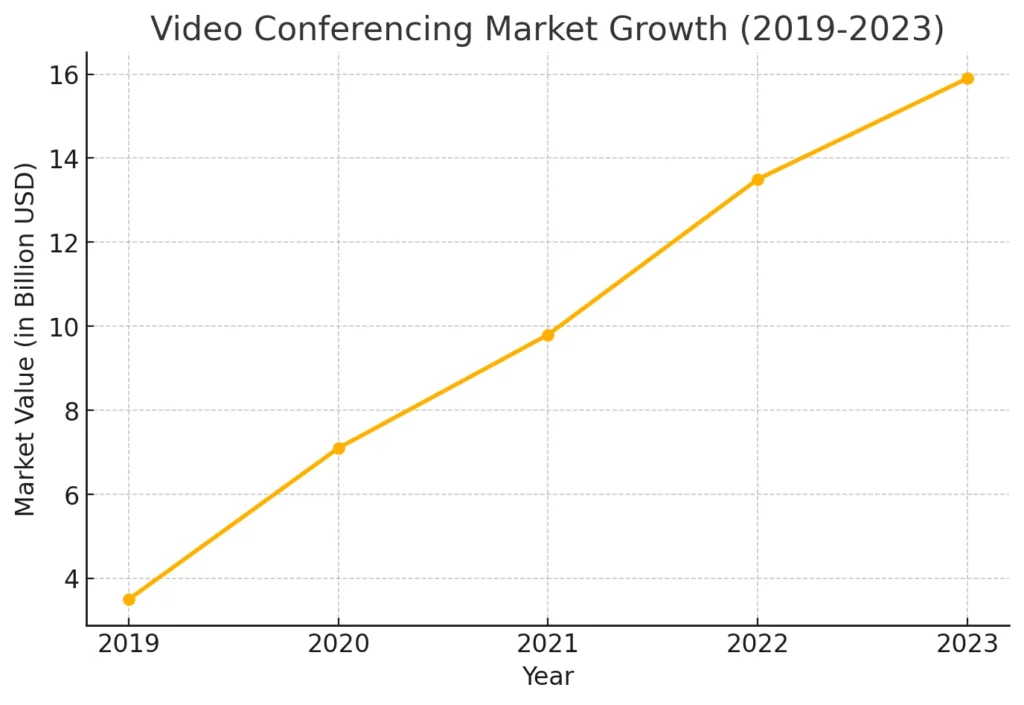In today’s hybrid world, video conferencing apps have become essential for both personal and professional communication. Platforms like Skype have led the way, enabling millions of users worldwide to connect through high-quality voice and video calls. With the growing demand for virtual meetings and collaborations, building a Skype clone offers a lucrative opportunity for developers and businesses to enter the thriving video conferencing market.
Whether you aim to create a platform for remote work, online education, or personal use, understanding the features, development process, and technologies behind apps like Skype is crucial. This guide offers a comprehensive look into building a Skype clone, from choosing the right tech stack to integrating essential features that engage users and drive success.
Understanding the Basics of a Skype Clone
A Skype clone replicates the core functionalities of Skype, allowing users to connect via voice calls, video conferencing, and messaging in real-time. These apps serve various purposes—from business meetings to personal connections and online education.
Developing such an app isn’t just about recreating Skype; it’s about crafting a unique experience that offers reliability, scalability, and modern features that match current user expectations.
Market Relevance:
- Video conferencing apps surged in popularity after the COVID-19 pandemic. Skype and Zoom became essential tools for businesses, educators, and families to stay connected remotely.
Why Develop a Skype Clone?
- Entering this market now offers opportunities to cater to specific niches (education, enterprise, or entertainment).
- With new advancements in AI and augmented reality, a custom video conferencing app can stand out with innovative features beyond what Skype provides.
Creating a Skype clone is not just about replicating functionality; it’s about adding features that improve performance, user engagement, and security while meeting the growing demand for virtual interaction.
Lesen Sie auch: -Guide to Building an App Like Zoom
Key Features to Include in Your Skype Clone
To build a successful Skype clone, you must integrate essential features that match user expectations while incorporating additional functionalities to enhance user experience. Here are the core features every video conferencing app needs:
| Besonderheit | Beschreibung | User Benefit |
|---|---|---|
| Video & Voice Calls | Real-time communication through high-quality video/voice | Seamless communication experience |
| Bildschirmfreigabe | Share screens during meetings | Better collaboration for business |
| Call Recording | Record important calls and meetings | Easy reference and documentation |
| Ende-zu-Ende-Verschlüsselung | Secure calls with encrypted data | Privacy and data security |
| Group Conferencing | Host multiple participants in one session | Ideal for remote teams and events |
1. Video and Voice Calls
- Provide high-quality video and audio calling features with support for individual and group calls.
- Implement adaptive bitrate streaming to ensure smooth communication, even with limited bandwidth.
2. Messaging System
- Offer instant messaging for users to communicate seamlessly during and outside of video calls.
- Include text chats, emojis, and file sharing to enhance engagement.
3. Group Video Calls and Screen Sharing
- Enable multi-user video calls for virtual meetings, education, or family gatherings.
- Add screen sharing capabilities to facilitate presentations and collaboration.
4. Cloud-Based Recording and File Sharing
- Allow users to record video meetings and store them on the cloud for future reference.
- Integrate secure file-sharing options for documents, presentations, or images during meetings.
5. End-to-End Encryption
- Prioritize user privacy with secure end-to-end encryption, ensuring that conversations and data remain confidential.
6. User Status and Availability
- Implement features like status updates (available, busy, in a meeting) to enhance communication efficiency.
7. Push Notifications
- Provide real-time alerts for incoming calls, messages, and scheduled meetings to keep users informed and engaged.
By focusing on these core features, you can ensure your app offers functionality that appeals to both individual users and businesses, creating a well-rounded communication platform.
The Development Process: Step-by-Step Guide to Building a Skype Clone
Creating a Skype clone involves several critical steps, from planning to post-launch support. Here’s a structured approach to building your video conferencing app:

1. Develop a Business Plan and Monetization Strategy
- Identify your target audience—enterprise users, educators, or casual users.
- Choose a monetization model, such as in-app advertising, premium subscriptions, or pay-per-use features (e.g., cloud recording).
2. Choose Essential Features for the MVP (Minimum Viable Product)
- Start with core features: messaging, video and voice calls, and file sharing.
- Implement an easy-to-use user interface (UI) to encourage adoption.
- Plan for additional features (e.g., AI-powered meeting summaries) that can be added after launch.
3. Select the Right Technology Stack
- Frontend: React Native or Flutter for cross-platform development (iOS, Android, web).
- Backend: Node.js or Django for scalable backend services.
- WebRTC: Use this open-source technology to enable real-time video and audio communication.
4. Build a User-Friendly UI/UX Design
- Focus on a minimalistic, intuitive design for easy navigation.
- Include elements like video call buttons, chat interfaces, and status indicators for seamless interaction.
5. Integrate Payment Gateways and Monetization Options
- Add payment processors like Stripe or PayPal for subscriptions or pay-per-feature options.
- Include freemium or ad-supported models to attract more users initially.
6. Test the Application Extensively
- Conduct functional, compatibility, and load testing to ensure smooth operation across devices and platforms.
- Stress-test the app to ensure it can handle high user loads without crashes.
7. Launch and Promote the App
- Release the app on Google Play and the App Store.
- Develop a marketing strategy that includes social media campaigns and collaborations with influencers.
Following this structured approach ensures the development process is smooth, with minimal delays, and that the final product aligns with market demands and user expectations.
A well-planned go-to-market strategy plays a crucial role in ensuring a mobile app product’s success. For Skype clone developers, implementing an efficient launch plan can streamline user acquisition and retention. RipenApps provides an in-depth guide on how to craft and execute a winning go-to-market strategy for mobile app products, ensuring a smooth market entry.
While building a Skype clone, it’s essential to consider future scalability and market opportunities. Incorporating features like OTT streaming can broaden your app’s use cases, making it suitable for virtual events, webinars, or even content distribution. OTT platforms have revolutionized how users consume media, providing seamless streaming experiences across devices. Understanding the core principles of building OTT platforms for streaming can give your app a competitive edge, ensuring it meets diverse user demands in the ever-evolving digital landscape.
Lesen Sie auch: - How to Build OTT Apps: Streaming Made Easy
Tech Stack for Building a Skype Clone
Choosing the right tech stack is crucial for creating a high-performing video conferencing app. Below are the recommended tools and technologies for both the frontend and backend of your Skype clone.
| Development Area | Recommended Technologies | Zweck |
|---|---|---|
| Front-End Development | React Native, Flutter | Cross-platform app interface |
| Back-End Development | Node.js, Python, Ruby on Rails | Server-side logic and functionality |
| Echtzeitkommunikation | WebRTC, Twilio | Video and voice communication |
| Cloud-Hosting | AWS, Microsoft Azure | Hosting and scalability |
| Datenbank | PostgreSQL, MySQL | Store user data and messages |
1. Frontend Development (User Interface)
- Rahmenbedingungen: React Native or Flutter (for cross-platform apps on iOS, Android, and web)
- Languages: JavaScript, TypeScript
- Markup Languages: HTML5, CSS3 for web components
2. Backend Development (Server and Logic)
- Programmiersprachen: Node.js, Django, or Ruby on Rails for scalable backend services
- WebRTC: For real-time voice, video, and data transmission
- Datenbank: PostgreSQL, MySQL for structured data storage
- Web Servers: Nginx or Apache to manage requests and content delivery
3. Cloud Infrastructure
- Amazon Web Services (AWS) oder Google Cloud for hosting and file storage
- AWS S3: To store recordings and shared files
- EC2 Instances: For running backend processes and managing scaling needs
4. Security and Authentication
- End-to-End Encryption (E2EE): 256-bit TLS encryption to secure communications
- Zwei-Faktor-Authentifizierung (2FA): Google Authenticator or Microsoft Authenticator integration
5. Zahlungsintegration
- Streifen oder PayPal: To handle in-app payments for subscriptions and premium features
This tech stack ensures that the app is not only robust and scalable but also user-friendly and secure, meeting the high demands of today’s users.
Monetization Strategies for a Skype Clone
Building a video conferencing app isn’t just about functionality—it’s also about sustainability. Here are the key monetization strategies you can implement to generate revenue from your Skype clone:
| Strategy | Beschreibung | Example |
|---|---|---|
| Abonnements | Monthly/annual fees for premium features | Business subscription packages |
| In-App Werbung | Display ads to generate revenue | Video ads or banner ads |
| Freemium-Modell | Free version with paid upgrades | Unlock premium filters or features |
| Pay-Per-Use | Charge for specific features on-demand | Paid video conferences |
| Unternehmenslösungen | Offer custom integrations for businesses | Custom solutions for organizations |
1. Freemium Model
- Offer essential features for free while reserving premium tools (e.g., recording, advanced collaboration) for paying subscribers.
- Encourage free users to upgrade with time-limited trials of premium features.
2. Subscription Plans
- Provide tiered subscription options (monthly or annually) for businesses, educators, or individuals requiring advanced features.
- Include benefits such as higher participant limits or priority customer support for premium users.
3. Pay-Per-Use Features
- Charge for specific services like cloud recording, transcription services, or virtual event hosting on a per-use basis.
- This model appeals to users who don’t require long-term subscriptions.
4. In-App Advertising
- Display non-intrusive ads to free users.
- Offer an ad-free experience to premium subscribers, creating an additional incentive to upgrade.
5. Partnering with Third-Party Services
- Collaborate with SaaS tools (e.g., project management or CRM tools) to provide integrations for business users.
- Share revenue from users who purchase services through your platform.

These Monetarisierungsstrategien ensure your Skype clone generates sustainable income while offering value to users at different price points and levels of engagement.
Ensuring Security and Compliance for Your Skype Clone
Security is a top priority when developing a video conferencing app. Protecting user data, communications, and payments will help build trust and meet regulatory standards. Here are essential security practices and compliance strategies to implement:
1. End-to-End Encryption (E2EE)
- Secure all communications, including voice, video, and messages, with E2EE to prevent unauthorized access.
- Use 256-bit TLS encryption to safeguard data in transit.
2. Two-Factor Authentication (2FA)
- Enhance account security by requiring users to authenticate through 2FA tools like Google Authenticator.
- This reduces the risk of unauthorized access, even if passwords are compromised.
3. GDPR and CCPA Compliance
- Ensure the app follows data privacy regulations such as the General Data Protection Regulation (GDPR) and the California Consumer Privacy Act (CCPA).
- Provide clear policies on data usage and allow users to manage their personal data preferences.
4. Regular Security Audits and Penetration Testing
- Conduct periodic security audits to identify vulnerabilities.
- Hire ethical hackers to perform penetration tests, ensuring your app is resilient to cyberattacks.
5. Secure Payment Handling
- Use PCI-compliant payment gateways like Stripe or PayPal to manage in-app transactions securely.
- Protect sensitive payment data using encryption and tokenization technologies.
By implementing these security measures, you ensure a secure and trustworthy environment for users, fostering long-term loyalty and regulatory compliance.
Lesen Sie auch: - Top Features for Video Conferencing Apps
Launching and Marketing Your Skype Clone
A well-planned launch and marketing strategy ensures your video conferencing app reaches the right audience and gains traction. Follow these steps to position your app effectively in the market:

1. Pre-Launch Marketing
- Build a landing page to generate interest and collect early sign-ups.
- Create teaser campaigns across social media platforms to build anticipation.
- Reach out to influencers and early adopters to generate buzz.
2. App Store Optimization (ASO)
- Optimize your app’s listing on Google Play and the App Store with relevant keywords, engaging descriptions, and compelling visuals.
- Encourage users to leave reviews to boost visibility and credibility.
3. Leverage Social Media Marketing
- Run targeted ad campaigns on platforms like Instagram, Twitter, and LinkedIn to reach your ideal audience.
- Share educational content, such as tutorials or webinars, to engage potential users.
4. Offer Launch Discounts and Promotions
- Provide limited-time discounts on subscription plans or premium features to attract early users.
- Offer referral bonuses to encourage existing users to invite others.
5. Collaborate with Business Partners
- Form strategic partnerships with educational institutions, remote work platforms, or event organizers to promote your app within relevant communities.
6. Monitor Metrics and User Feedback
- Track user acquisition, engagement, and retention metrics to assess the success of your launch.
- Collect and analyze feedback from users to implement improvements and enhance user experience.
By combining a thoughtful marketing strategy with consistent user engagement, you’ll ensure a smooth launch and position your Skype clone for long-term success.
The global video conferencing market has surged in recent years, driven by remote work trends and growing digital collaboration. According to Statista, the market value for video conferencing apps is projected to reach unprecedented levels, highlighting the potential for new entrants like Skype clones to thrive.
Abschluss
Creating a Skype clone offers immense opportunities in the ever-growing landscape of video conferencing and communication tools. From selecting the right tech stack to ensuring robust security, every step plays a vital role in shaping the app’s success. Focusing on user-centric design, seamless performance, and effective monetization strategies ensures you deliver both value and sustainability.
By building trust through security measures and continuously improving the app based on user feedback, your platform can stand out in a competitive market. A well-executed launch, combined with targeted marketing efforts, will help attract the right audience and foster long-term growth. With the increasing demand for video conferencing solutions across industries, your Skype clone can become a go-to platform for individuals, businesses, and educators alike.
Ready to Build Your Skype-Klon?
Looking for expert guidance to bring your video conferencing app to life? Partner with Wunder to leverage cutting-edge development services and industry expertise. Whether you need customized features, seamless integrations, or top-tier security, Miracuves ensures your app meets all expectations and stands out in the market. Start your journey toward building the next great communication tool today with Miracuves!
FAQs
What essential features should a Skype clone have?
A successful Skype clone should include features like video and voice calls, instant messaging, group conferencing, screen sharing, file sharing, end-to-end encryption, and call recording to meet user needs effectively.
How much time does it take to develop a Skype clone?
The development time depends on the app’s complexity. A basic app with core features may take 3-6 months, while a fully-featured enterprise-grade solution can take up to a year, including testing and optimization phases.
What technology stack is recommended for building a Skype clone?
The ideal tech stack includes WebRTC for real-time communication, React Native for cross-platform development, and AWS for cloud hosting. For native apps, Swift (iOS) and Kotlin (Android) are popular choices.
How can I monetize my Skype clone?
You can generate revenue through subscription plans, in-app advertisements, pay-per-use features, and premium services. Offering enterprise-level subscriptions and custom integrations can also attract businesses.
Why choose Miracuves for developing a Skype clone?
Miracuves provides expert development services with a focus on security, scalability, and user-centric design. With experience in building custom communication platforms, Miracuves can help create a robust, market-ready Skype clone tailored to your business needs.





























































